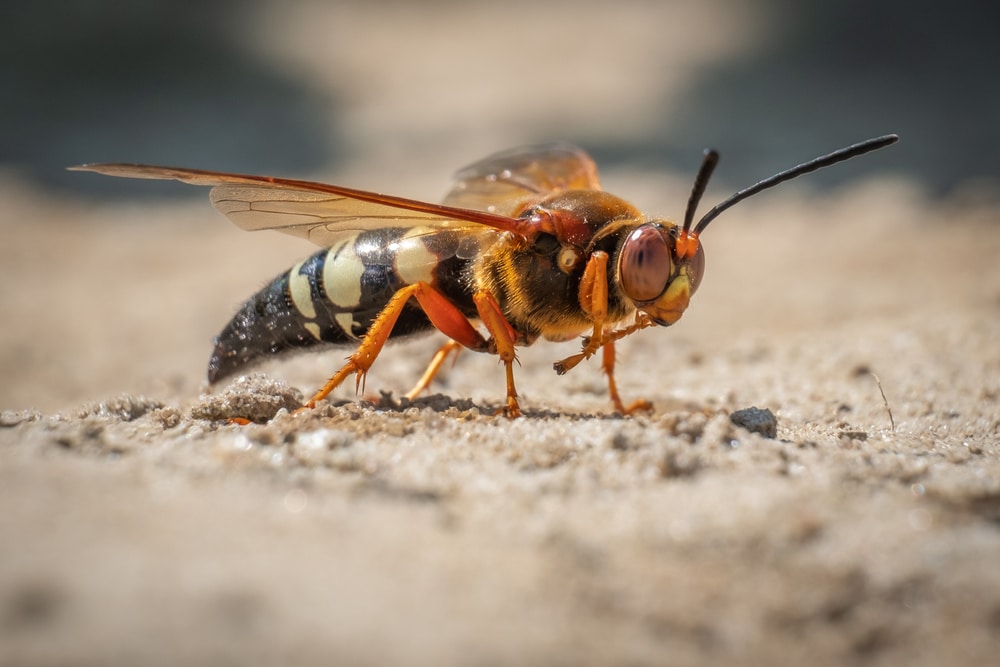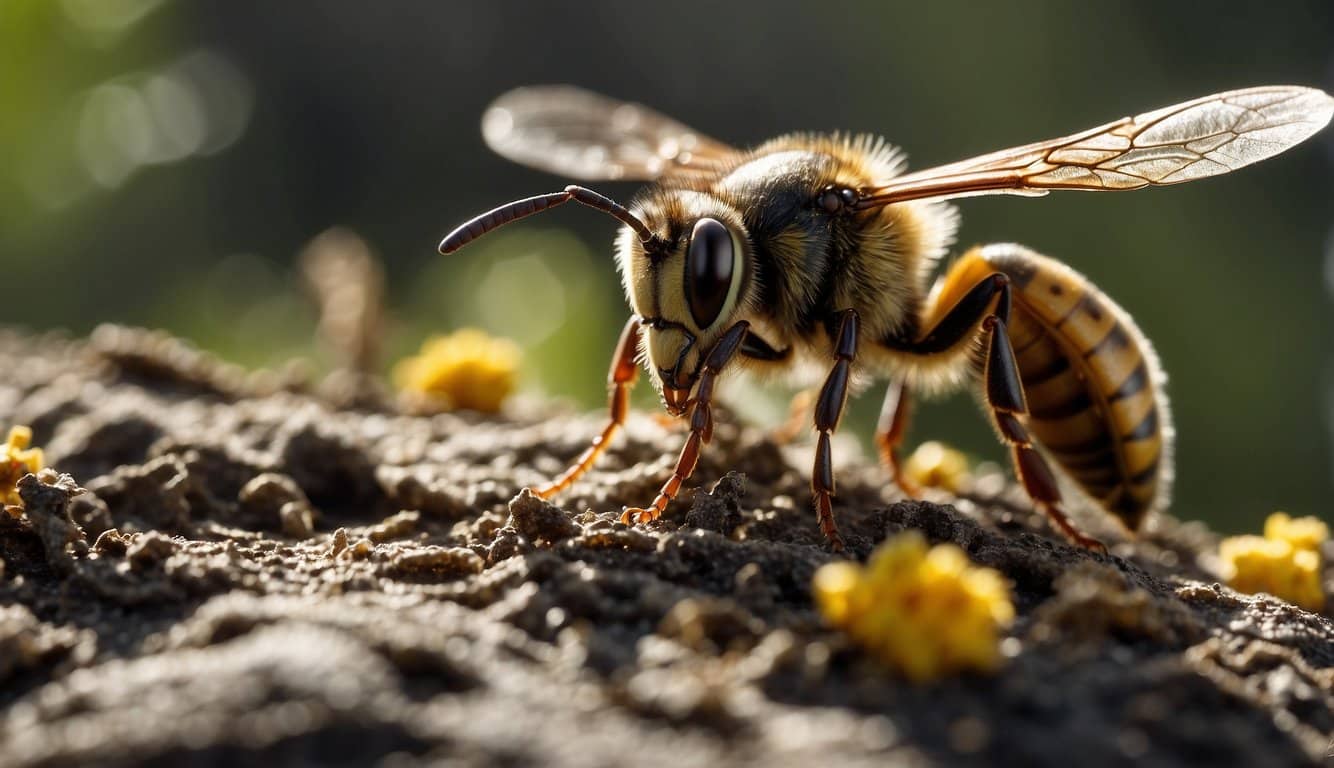Are You Looking at a Hornet / Hornets Nest?
Before you gear up for battle against these buzzing intruders, it’s critical you know exactly who you’re up against.
Hornets aren’t your average wasp—they’re bigger, bolder, and require a specific approach.
Recognizing Hornet Species
- Size and Color: Hornets are substantial in size, and you can spot them by their black and white or brownish-red coloration.
- These aren’t petite bugs; they mean business with their hefty bodies that can grow up to 2 inches long.
- Behaviors: Watch for their homing instincts.
- Unlike other insects, hornets tend to display aggression if they sense a threat to their home. If you see a swarm near a nest, tread carefully.
To learn more about hornet identification, check out Bob Vila’s take on hornet identification.
Hornet Nests Vs. Wasp Nests
- Hornet Nests:
- Look out for football-shaped nests, often found high up in trees or under eaves. These are hornet high-rises, and they’re made from a papery substance the hornets craft by chomping on wood fibers.
- Expect to find these nests being heavily guarded, and don’t be surprised if they’re larger than a basketball—it’s a hornet thing.
- Wasp Nests:
- More umbrella-like in structure and usually open and exposed, wasp nests are a different beast.
- They’re typically smaller and may hang from a single, precarious stalk.
- Wasps don’t usually reuse their nests, whereas hornets might refurbish last year’s model, so watch for activity.
When differentiating between these two types of nests, closely inspect images of hornet nests for a visual guide.
Preventive Measures

Landscape Management
- Trim Vegetation Regularly: Hornets are attracted to dense foliage for nest building.
- Keep shrubs and trees well-pruned to discourage hornets from settling in.
- Proper Waste Management: Ensure your garbage cans and recycling bins have tightly fitted lids.
- Hornets are scavengers and will flock to any easily accessible food source.
- Water Feature Maintenance: Standing water can attract hornets.
- Maintain birdbaths and ensure gutters are clear so water flows freely instead of creating hornet-friendly puddles.
Natural Repellents
- Peppermint Oil: Hornets dislike the strong scent of peppermint.
- Mix a few drops of peppermint oil with water and spray it around your outdoor areas.
- Cucumber Slices: Place slices of cucumber in areas prone to hornet activity.
- The bitter compounds in the cucumber skin help deter these flying insects.
Safe Removal Strategies
When dealing with hornets, safety should be your top concern. Here’s how you can kick those stingers out without turning yourself into a pincushion!
Professional Extermination
- Contact the Pros: Reach out to a professional pest removal service.
Aftermath and Repair
After you’ve won the battle against hornets, it’s time to deal with the remnants of war: the nest and any damage. It’s not just about aesthetics; it’s about ensuring your fortress is restored to its peaceful state.
Nest Removal
- Gear Up Again: Just because the hornets are gone doesn’t mean you should ditch the gear.
- Suit up with protective clothing one last time to prevent any straggler stings.
- Careful Disposal: If you’re confident the nest is inactive, place it into a sealed bag or container and dispose of it according to your local waste management guidelines.
Repairing Damage
- Assess the Impact: Inspect the area for any damage the hornets may have caused, such as chewed wood or remnants of the nest adhesive.
- Restore and Patch: Use wood filler for any holes or grooves in wooden structures.
- For siding or painted surfaces, gently scrape off any residue before patching and repainting.
- Future Prevention: Consider treating the area with a repellent to deter future pests from setting up shop.
Maintaining a Hornet-Free Zone
Creating a hornet-free zone is all about being proactive and smart. Let’s keep those pesky buzzers away so you can enjoy your backyard barbecues without uninvited striped guests!
Regular Inspection:
- Check Your Premises: Regularly walk around your property to check for hornet nests. Early detection makes removal easier and safer.
- Seal Entry Points: Hornets love to set up shop in undisturbed places.
- Seal off any openings in your home’s exterior, such as eaves or attic vents.
Natural Repellents:
- Mint Magic: Plant mint or spray a peppermint hornet repellent around your outdoor spaces.
- Hornets detest the smell.
- Coffee Grounds: Sprinkle used coffee grounds where you suspect hornets might wander. It’s a natural and aromatic deterrent!
Preventive Measures:
- Trash Management: Keep your outdoor trash bins sealed and away from your house.
- Hornets are drawn to sweet and protein-rich waste.
- Fruit Patrol: Fallen fruits can be a hornet magnet. Clear them out promptly to avoid a fruity fiesta.
- Water Features: If you have birdbaths or ponds, keep them clean to prevent hornets from using them as a water source.
Decoy Nests:
- Fake Out!: Hang up a hornet decoy nest.
- These simulate an “already claimed” area, and hornets will usually steer clear of competitor territories.
Frequently Asked Questions
In this section, you’ll find concise and practical answers to common questions about dealing with those buzzing intruders, hornets.
From natural remedies to removing nests, we’ve got you covered.
What are some effective natural remedies for dealing with hornets?
- Mixing essential oils like clove, peppermint, or lemongrass with water and dish soap can create a DIY hornet repellent.
- Hornets detest the strong smell, so spray this mix where you notice hornet activity and repeat every few days until they buzz off.
What steps can I take to quickly get rid of hornets in my backyard?
- Identify the location of the nest during the day.
- Approach the nest at night when hornets are less active and spray it with an insecticide from a safe distance.
- Continue monitoring and repeat the process if necessary, as disciplined in Forbes.
What methods can help eliminate hornets inside my home?
- Seal entrances and windows to prevent hornets from entering.
- Use traps baited with sugar water or meat to lure hornets in and trap them, as suggested by practical steps found on Bob Vila’s website.
How can I safely remove a hornet’s nest from the ground?
- Wear protective clothing to prevent stings.
- Apply an aerosol insecticide directly at the nest’s entrance and wait for the hornet activity to cease before removing the nest, as outlined by wikiHow.
What are the best ways to use vinegar for hornet control?
- Create a trap by mixing equal parts sugar, water, and vinegar in a container with a funnel at the top.
- Hornets will be attracted to the mixture but find it difficult to escape, drowning in the solution.
How can I dispose of a hornet’s nest in a wall without being stung?
- Approach the nest at night wearing protective gear.
- Drill a small hole and inject insecticide into the nest. Alternatively, apply dust insecticide around the entrance to poison the hornets effectively.
- Ensure it’s safe to remove after a few days of observation.
Last update on 2025-06-06 / Affiliate links / Images from Amazon Product Advertising API




